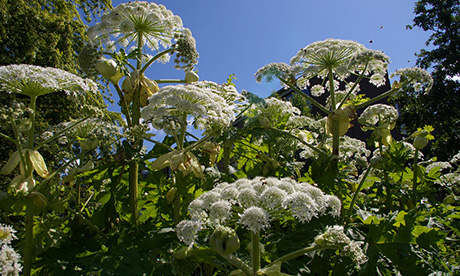Toxic hogweed plants spotted on Hackney Marshes
Highly toxic giant hogweed plants have been spotted on Hackney Marshes.
The plant, which can grow to heights of three metres, has been sighted around the Middlesex Filter Beds and the surrounding woodland.
The leaves and stem of the plant contain a sap which causes significant blistering and swelling on contact with skin.
Five children from the Greater Manchester area were admitted to hospital in the last week with chemical burns on their arms and bodies from the plant, while a woman in Enfield suffered similar burns to her legs.
Hackney Council confirmed that giant hogweed had been found along areas of the River Lea and said it expected the plants would be “completely removed” by this winter.
A council spokesperson said: “Hackney Council regularly treats invasive plant species, such as giant hogweed, along areas of the River Lea which runs through the Marshes.
The council said that weeds along the River Lea usually occur due to its openness and shape which acts as a wind tunnel for seeds to easily travel and germinate.
Giant hogweed – also known by its binomial name Heracleum mantegazzianum – commonly grows near rivers or canals, or in wetlands and was first recorded in the wild in the UK in 1828, according to the Government’s Non-Native Species Secretariat.
Native to the Caucasus mountains of south-west Russia, the plant was originally brought to England by Victorian plant hunters as a garden ornamental.
No injuries reported
When asked if giant hogweed was becoming more prevalent, Karen Harper of the London Invasive Species Initiative (LISP) said: “Invasive species don’t respect administrative boundaries. Giant hogweed is so widely spread that it is impossible to say whether it is on the rise. The data just does not work that way”
Adam Wallace from Natural England, the Government’s environmental advisory body, said: “Giant hogweed can be prolific, shading out native plants and reducing wildlife habitat.
“It is an offence to plant or encourage giant hogweed to grow in the wild, and we would encourage landowners to be aware of giant hogweed as an issue so if they wish they can control it.”
A spokesperson from the Department of Environment of Food and Rural Affairs (Defra) added: “The problems with the giant hogweed highlight the importance of protecting our borders from invasive non-native species, which can threaten our natural environment and the UK’s biodiversity.”
Hackney Council said there had so far been no reports of any injuries caused by the giant hogweed and encouraged people to report any sightings.

